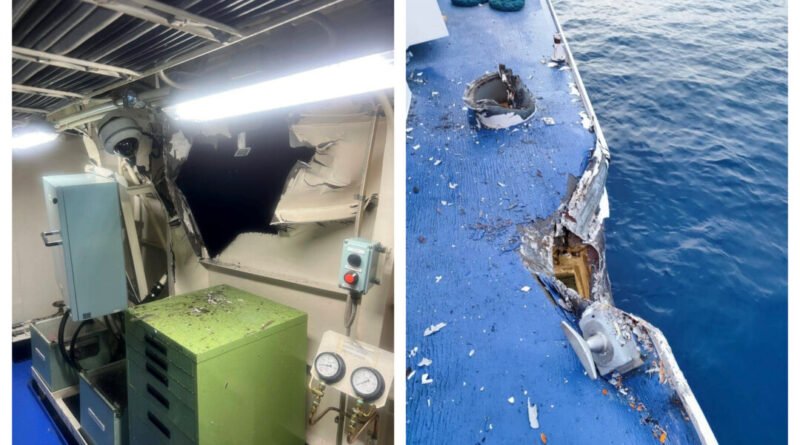Accusations Fly Between China and Philippines Following Coast Guard Vessel Collision
The Philippines stated that two vessels were damaged by ‘unlawful and aggressive maneuvers’ after the incident where China blamed the Philippines.
China and the Philippines accused each other on Monday following a collision between their coast guard vessels in the South China Sea, just days after an altercation in the air.
The China Coast Guard alleged that a Philippine vessel intentionally collided with a Chinese one, while the Philippines claimed that hazardous maneuvers by two China Coast Guard ships caused damage to two Philippine Coast Guard vessels.
This incident occurred amidst growing tensions between Beijing and Manila and adds to a series of conflicts between the two nations since disputes over sovereignty claims in the region intensified over the past two years.
The collision took place early Monday near the Sabina Shoal, also known as the Escoda Shoal to the Philippines or Xianbin Jiao (Reef) to the Chinese, in an area of the South China Sea referred to by the Philippines as the West Philippine Sea.
According to Philippine authorities, two Philippine Coast Guard vessels, BRP Bagacay (MRRV-4410) and BRP Cape Engaño (MRRV-4411), were en route to deliver supplies to outposts on Patag and Lawak Islands, which China designates as the Feixin and Nanshan Islands, when the collisions occurred.
The China Coast Guard initially publicized the incident by sharing two videos on Chinese social media platforms, claiming they depicted a collision between the MRRV-4410 and China’s CCGV 21551.
Captions on the footage alleged that MRRV-4410 attempted to collide with China’s CCGV 21551 at 3:23 a.m., unsuccessfully, before successfully doing so in a second attempt at 3:25 a.m.
In a statement released by China’s state-run Xinhua News Agency, China Coast Guard spokesperson Gan Yu stated that MRRV-4410 ignored multiple warnings and intentionally rammed into CCGV 21551 in an unprofessional and dangerous manner.
Gan asserted that China Coast Guard personnel were following the law by engaging with the two Philippine vessels after they entered the area without permission from the Chinese regime.
He placed the blame solely on the Philippines, accusing them of provocations and warning of consequences.
In another statement via Xinhua, Gan mentioned that MRRV-4410 continued to trespass in an area of the sea near the Second Thomas Shoal, also known as Renai Reef by the Chinese and Ayungin Shoal by the Philippines.
At a daily briefing, Mao Ning, a spokesperson for China’s Ministry of Foreign Affairs, stated, “Not only did they ignore China’s Coast Guard’s warnings, the vessels deliberately collided with Chinese Coast Guard vessels, who were carrying out law enforcement operations, in a dangerous manner.”
The Philippines countered China’s version of events.
Jonathan Malaya, assistant director general at the National Security Council of the Philippines, said in a statement that the two Philippine vessels encountered unlawful and aggressive maneuvers from Chinese Coast Guard vessels while heading to the Patag and Lawak Islands in the West Philippine Sea.
“These dangerous maneuvers resulted in collisions, causing structural damage to both Philippine Coast Guard vessels,” the statement read.
China’s CCGV-3104 collided with the Philippines’ MRRV-4411 around 3:24 a.m. At 3:40 a.m., MRRV-4410 was reportedly rammed twice on both the port and starboard sides by CCGV 21551, resulting in minor structural damage according to the statement.
The National Task Force for the West Philippine Sea (NTF-WPS) announced that both vessels would continue their mission of delivering essential supplies.
In a statement on social media platform X, U.S. Ambassador to the Philippines MaryKay Loss Carlson condemned the behavior of the Chinese regime and reiterated U.S. support for the rights of the Philippines under international law.
“The United States stands with the Philippines in condemning the China Coast Guard’s dangerous maneuvers near Sabina Shoal that endangered lives and caused damage to two Philippine Coast Guard vessels. We are committed to supporting the rights of our #FriendsPartnersAllies under international law,” she wrote.
On Aug. 16, a Chinese Ministry of Foreign Affairs spokesperson informed the Chinese state-run Global Times, “The entry and prolonged stay of Philippine vessels in the lagoon of Xianbin Jiao without authorization seriously infringes on China’s sovereignty, violates the Declaration on the Conduct of Parties in the South China Sea, and poses a severe threat to peace and stability in the South China Sea.”
NTF-WPS spokesperson Commodore Jay Tarriela responded to this statement by affirming that the Escoda Shoal is situated within the Exclusive Economic Zone of the Philippines, in accordance with the United Nations Convention on the Law of the Sea and the 2016 arbitral award from The Hague.
Tarriela added that the Philippine Coast Guard retains the right to patrol the Escoda Shoal without permission from any other country and is present there to protect against illegal poaching and fishing activities that harm the marine environment.
China has warned the Philippines about intruding into what it considers its territorial waters and has implemented new rules, effective since June 15, to enforce a 2021 law allowing its coast guard to use lethal force against foreign ships in claimed waters.
Under these new rules, the China Coast Guard can detain suspected trespassers without trial for 60 days.
Two days after the law came into effect, China Coast Guard personnel boarded Philippine supply boats on June 17.
Philippine military officials reported that Chinese coast guard personnel were armed with knives and spears, looted firearms, deliberately damaged Philippine boats involved in the mission, and caused an injury where a sailor lost a finger.
The Philippines has demanded 60 million pesos (approximately $1 million) in damages from the Chinese communist regime following that incident.
Earlier this month, the Philippines accused the Chinese military of engaging in “dangerous and provocative actions” by dropping flares in the flight path of a Philippine patrol plane on Aug. 8, thereby endangering the crew, while the Chinese air force maintained its actions were “professional” and “justified.”
Catherine Yang and Aaron Pan contributed to this report.




